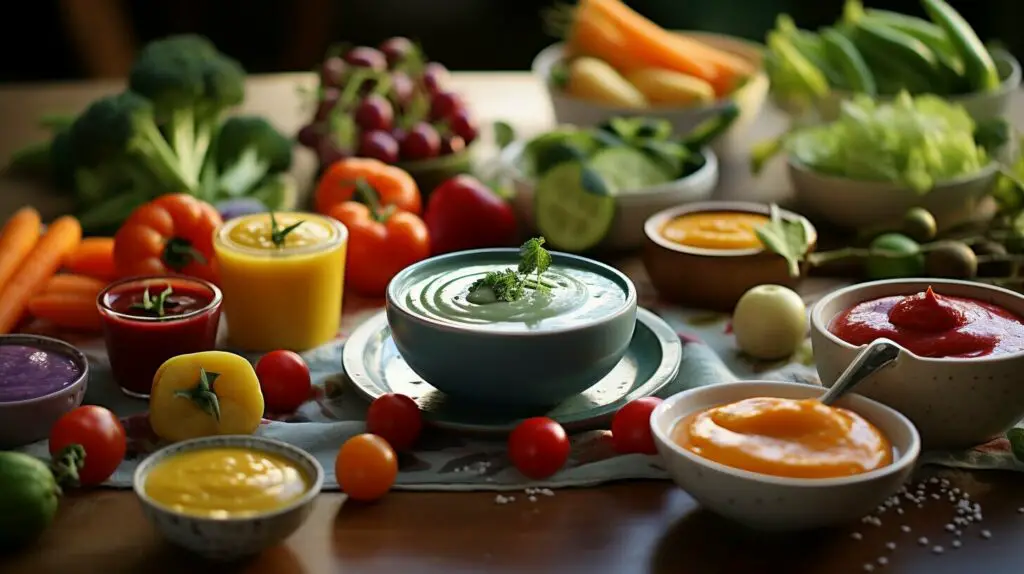Introducing solid foods to your baby is an exciting milestone, but it can also be overwhelming. Choosing the right foods that are nutritious and appealing to your little one can be a challenge. Vegan baby led weaning is a wonderful approach that allows your baby to explore food at their own pace and develop a love for healthy, plant-based options.
Baby led weaning involves offering your baby a variety of finger foods that they can self-feed, rather than purees or spoon-feeding. This approach encourages independence, promotes healthy eating habits, and develops hand-eye coordination.
In this article, we’ll share some easy and nutritious vegan baby led weaning recipes, offer tips for meal planning and grocery shopping, and explore the benefits of introducing the whole family to plant-based options.

Key Takeaways:
- Vegan baby led weaning involves offering finger foods for self-feeding.
- This approach promotes independence, healthy eating habits, and hand-eye coordination.
- We will provide simple and wholesome vegan baby led weaning recipes and tips for meal planning and grocery shopping.
- Vegan baby led weaning is a great opportunity to introduce the whole family to plant-based options.
What is Vegan Baby Led Weaning?
Introducing solids to your baby can be an exciting yet daunting time, but with baby led weaning, the process can be fun and stress-free. Baby led weaning is a method of introducing complementary foods to babies by allowing them to self-feed. Unlike traditional weaning methods that rely on purees and spoon-feeding, baby led weaning encourages the baby to explore and experiment with finger foods, developing their independence and self-feeding skills.
When practicing vegan baby led weaning, the focus is on offering a variety of textures and flavors to develop the baby’s palate and ensure their nutritional needs are met. This approach also helps parents avoid the common pitfalls of relying on processed and pre-packaged baby food, ensuring their little one receives a wholesome and healthy diet from the start.
As babies develop their motor skills and hand-eye coordination, they become more adept at self-feeding and exploring different foods. Vegan baby led weaning allows them to do this at their own pace, building their confidence and promoting healthy eating habits from an early age. The benefits of vegan baby led weaning are vast and including better digestion, chewing and swallowing skills, and developing a lifelong love for healthy foods.
Easy Vegan Baby Led Weaning Recipes
Vegan baby led weaning recipes are all about introducing healthy and nutritious finger foods to your little one. These foods are soft and cooked enough to be safe for self-feeding. Here are some easy vegan baby led weaning recipes to try:
| Recipes | Description |
|---|---|
| Soft Vegetable Sticks | Carrots, sweet potatoes, squash, and zucchini cooked until tender. These are perfect for babies starting on solids. |
| Fruits | Soft and ripe fruits such as bananas, avocados, and mangoes are easy to eat and provide valuable nutrients for your baby. |
| Whole Grain Puffs | Whole grain puffs made from brown rice, quinoa, and millet. These are a great alternative to traditional baby puffs, which can contain additives and preservatives. |
| Mashed Beans | Mashed chickpeas, black beans, or white beans are a great source of protein and fiber for your little one. |
These vegan baby led weaning recipes are easy to prepare and provide your baby with the nutrients they need for healthy growth and development. Make sure to offer a variety of textures and flavors to help your baby develop their palate and explore new tastes.
Tips for Meal Planning and Grocery Shopping for Vegan Baby Led Weaning
Planning and preparing nutritious meals for your baby can be challenging, especially when following a vegan baby led weaning approach. However, with some smart meal planning and grocery shopping, you can simplify the process and ensure your baby is getting the nutrients they need.
Here are some tips for meal planning and grocery shopping for vegan baby led weaning:
| Tip | Description |
|---|---|
| Plan Ahead | Take time to plan your baby’s meals for the week, including snacks and finger foods. This will help you make sure they get a variety of nutrients and flavors and reduce stress during mealtime. |
| Batch Cook | Prepare meals in large batches and freeze them in individual portions. This saves time during busy days and ensures you always have healthy meals ready to go. |
| Use Convenient Alternatives | Look for frozen fruits and vegetables, canned beans, and other vegan staples for quick and easy meal prep. These alternatives are often just as nutritious as fresh produce and save time on meal prep. |
| Read Labels Carefully | Be sure to read labels when grocery shopping to ensure products are vegan-friendly and appropriate for your baby’s age and dietary restrictions. Look out for common allergenic ingredients, such as soy, wheat, and nuts, and always choose organic when possible. |
By following these tips, you can simplify meal planning and grocery shopping for vegan baby led weaning and ensure your little one is getting the nutrients they need to grow and thrive.
Vegan Baby Led Weaning Recipes for the Whole Family
Introducing your little one to vegan food can be an exciting and rewarding experience for the whole family. By incorporating wholesome vegan baby led weaning recipes into your family meals, you can offer your baby a wide variety of nutritious and delicious foods while introducing the family to plant-based options.
Here are some vegan baby led weaning recipes that the whole family can enjoy:
| Recipe | Description |
|---|---|
| Vegan Pancakes | These fluffy pancakes made with mashed bananas, oat flour, and plant-based milk make for a delicious and nutritious breakfast option for the whole family. |
| Chickpea Nuggets | These crispy and flavorful nuggets made with chickpeas, breadcrumbs, and spices are the perfect finger food for both babies and adults. |
| Sweet Potato and Lentil Soup | This hearty and comforting soup made with sweet potato, lentils, and spices is a great way to introduce your baby to different textures and flavors. |
By cooking meals that can be enjoyed by everyone, you can make mealtime a fun and inclusive experience for the whole family. It also helps to avoid having to cook separate meals for your baby, making meal planning and grocery shopping much more convenient.
When planning your family meals, consider incorporating a variety of plant-based proteins like lentils, chickpeas, and tofu, as well as whole grains, fruits, and vegetables. This will ensure that everyone in the family is getting a balanced and nutritious diet.
Introducing Allergens in Vegan Baby Led Weaning
When introducing your baby to solids, it’s important to include a variety of foods, including allergenic ones, to reduce the risk of allergies later in life. The American Academy of Pediatrics recommends introducing allergenic foods, such as peanuts, tree nuts, soy, and wheat, around 6 months of age. However, it’s essential to introduce them in a safe manner.
To prevent choking, it’s crucial to offer allergenic foods in an appropriate texture and form. For example, you can offer smooth peanut butter instead of whole peanuts or thinly sliced avocado instead of large chunks. It’s also a good idea to introduce new foods when your baby is well-rested, alert, and in a calm state.
It’s important to monitor your baby for any signs of an allergic reaction, such as itching, rash, difficulty breathing, or swelling. If your baby experiences any of these symptoms, seek medical attention right away. It’s also important to learn the difference between choking and gagging. While gagging is a normal part of learning to eat, choking is a medical emergency.
To reduce the risk of choking, always supervise your baby during mealtime and offer appropriate portion sizes. Avoid giving round or hard foods, such as popcorn, grapes, or hard candy, that can easily get lodged in your baby’s throat. Additionally, make sure your baby is seated in an upright position while eating and use safe feeding utensils, such as infant spoons and forks.
Overall, introducing allergens in vegan baby led weaning can be a safe and positive experience for your baby. With proper precautions and monitoring, you can help your little one develop a diverse and healthy palate.
Safety Considerations in Vegan Baby Led Weaning
When practicing vegan baby led weaning, safety should always be a top priority. As babies explore and experiment with new textures and flavors, it’s important to be aware of potential choking hazards and take necessary precautions to minimize the risk of accidents.
Here are a few tips to ensure a safe and enjoyable mealtime experience:
Monitor Mealtime
Always supervise your baby during mealtime to ensure they are safely and properly self-feeding. Avoid distractions like phones or TV and focus on your baby’s actions.
Offer Appropriate Portion Sizes
When offering finger foods, make sure the size and shape are appropriate for your baby’s age and development. Cut foods into manageable pieces and avoid large chunks or hard foods that could be choking hazards.
Use Safe Feeding Utensils
When using utensils to feed your baby, make sure they are safe and appropriate for their age. Avoid sharp objects or utensils with small pieces that could break off and pose a choking hazard.
Know the Signs of Choking
It’s important to know the signs of choking so you can act quickly if necessary. Signs include difficulty breathing, coughing, gagging, or turning blue. If your baby is choking, seek emergency medical attention immediately.
Take a CPR Class
Consider taking a CPR class to prepare yourself for any emergency situations. Knowing how to perform CPR can potentially save your baby’s life in the event of choking or other medical emergencies.
By following these safety considerations, you can help ensure a safe and enjoyable vegan baby led weaning experience for both you and your little one.
Nutritional Considerations for Vegan Baby Led Weaning
When it comes to vegan baby led weaning, ensuring that your little one is receiving all of the necessary nutrients is key. While a well-planned vegan diet can provide all the nutrients a baby needs, it’s important to pay attention to certain vitamins and minerals that may be harder to obtain from plant-based sources.
One important nutrient to keep in mind is iron. Babies require a lot of iron for healthy growth and development, and breast milk or formula may not provide enough after the first six months. To ensure your baby is getting enough iron, offer iron-rich foods such as fortified cereals, tofu, beans, and leafy greens.
Vitamin B12 is another important nutrient that may be harder to obtain on a vegan diet. It’s essential for brain and nervous system development, and babies require a daily intake. While breast milk does contain some B12, it’s important to supplement with a B12-fortified food or supplement to ensure your baby is getting enough.
Calcium is important for developing strong bones and teeth. While milk and dairy products are often the go-to source for calcium, there are plenty of plant-based sources as well. Offer foods such as fortified plant milks, tofu, almonds, and leafy greens to ensure your baby is getting enough calcium.
Protein is also important for growth and development, and while it’s abundant in many plant-based foods, it’s important to offer a variety of protein-rich foods to ensure your baby is getting enough. Ideas include beans, lentils, tofu, nut and seed butters, and whole grains.
Finally, consider supplementing with a vegan omega-3 supplement or ensuring that your baby is receiving enough from sources such as flaxseeds or chia seeds. Omega-3s are important for brain development and overall health.
| Nutrient | Sources |
|---|---|
| Iron | Fortified cereals, tofu, beans, leafy greens |
| Vitamin B12 | B12-fortified foods or supplements |
| Calcium | Fortified plant milks, tofu, almonds, leafy greens |
| Protein | Beans, lentils, tofu, nut and seed butters, whole grains |
| Omega-3s | Flaxseeds, chia seeds, vegan omega-3 supplements |
By offering a variety of nutrient-dense foods and supplementing where necessary, you can ensure that your baby is getting all the necessary nutrients to thrive on a vegan diet.
Additional Tips for Successful Vegan Baby Led Weaning
When it comes to vegan baby led weaning, there are a few additional tips to consider for a successful and enjoyable experience. Here are some ideas:
- Experiment with different alternatives to common allergenic ingredients. For example, try using sunflower seed butter instead of peanut butter or coconut milk instead of cow’s milk.
- Offer a variety of textures and flavors to keep things interesting and help your baby develop their palate. Mix it up with some soft foods, crunchy foods, and a variety of spices and herbs.
- Encourage independence by allowing your baby to explore and experiment with food at their own pace. Avoid forcing them to eat anything they don’t want to.
- Be patient and don’t stress if your baby doesn’t seem interested in certain foods at first. It can take some time for them to develop a liking for certain flavors and textures.
- Get creative with your meal planning and try different combinations of foods to keep things exciting. Remember, vegan baby led weaning is all about offering a healthy and varied selection of foods for your little one to enjoy.
By following these tips, you can help ensure a successful and enjoyable vegan baby led weaning experience for both you and your baby. With a little patience and experimentation, you’ll be able to provide your baby with the nutrition they need while helping them develop a lifelong love of healthy, plant-based foods.
Vegan Baby Led Weaning Recipes: Conclusion
Congratulations on embarking on the exciting journey of vegan baby led weaning! You now have an arsenal of wholesome recipes and practical tips for meal planning and grocery shopping. By offering a variety of flavors and textures, you are not only stimulating your baby’s palate but also laying the foundation for healthy eating habits.
Remember, vegan baby led weaning is all about fostering independence and allowing your baby to explore food at their own pace. As you introduce allergens and navigate potential choking hazards, always prioritize safety and consult with your pediatrician as needed.
We hope you enjoy trying out the easy vegan baby led weaning recipes we shared, and don’t forget to also make delicious plant-based meals for the whole family to enjoy together! Keep experimenting with different ingredients and flavors, and have fun watching your little eater grow into a healthy and adventurous eater.
Happy cooking!




